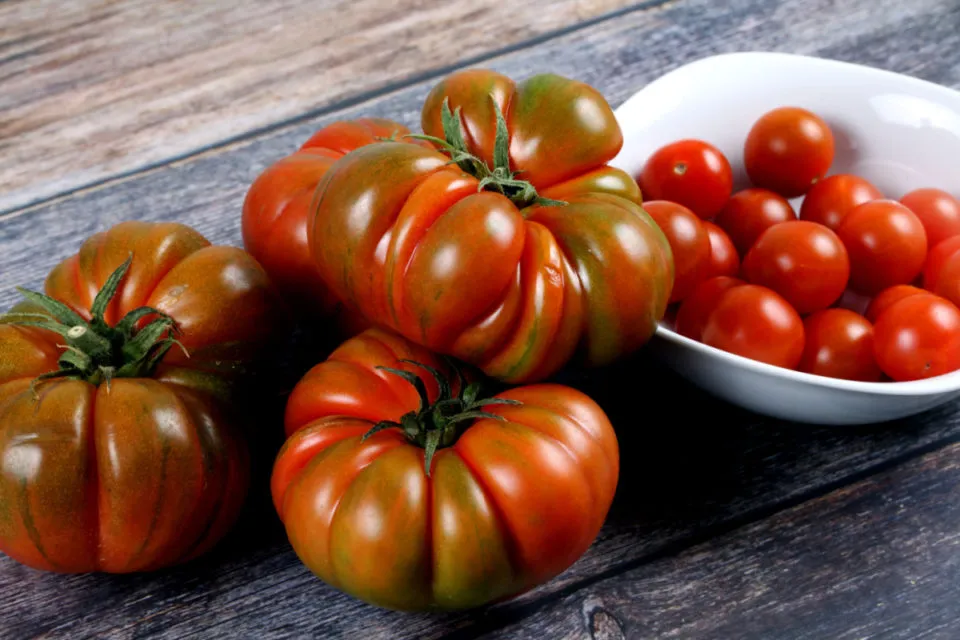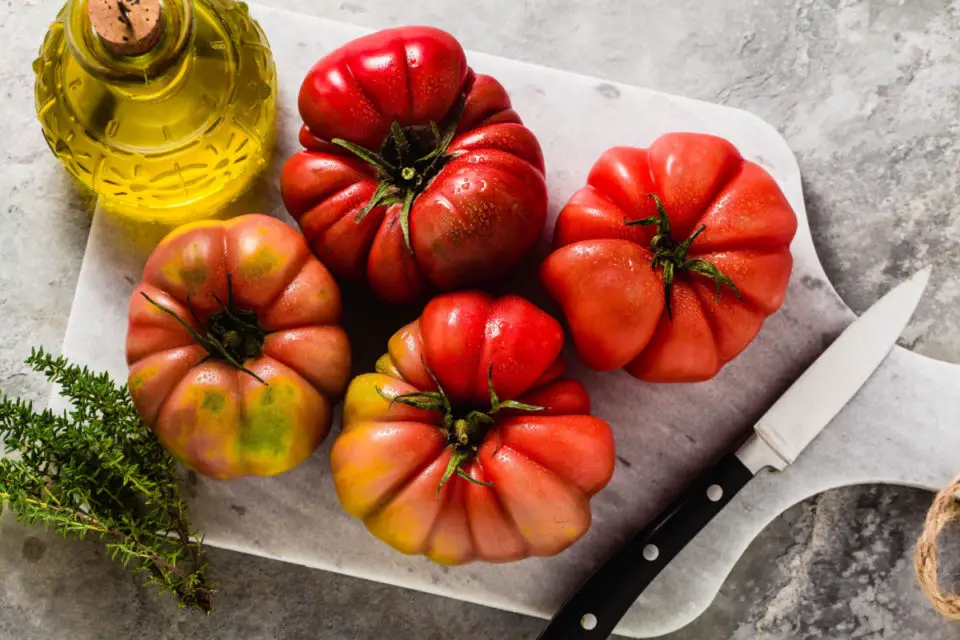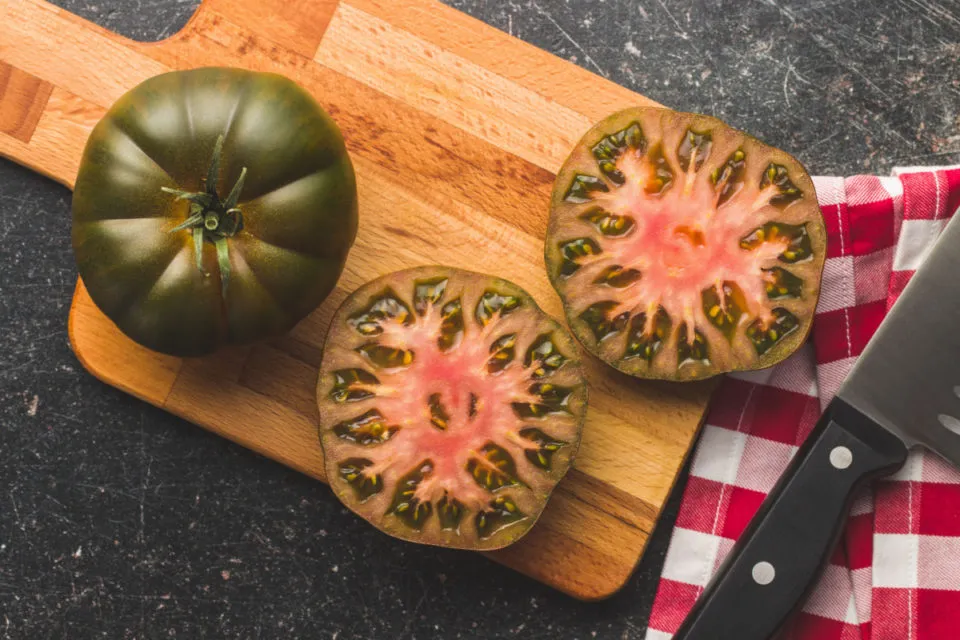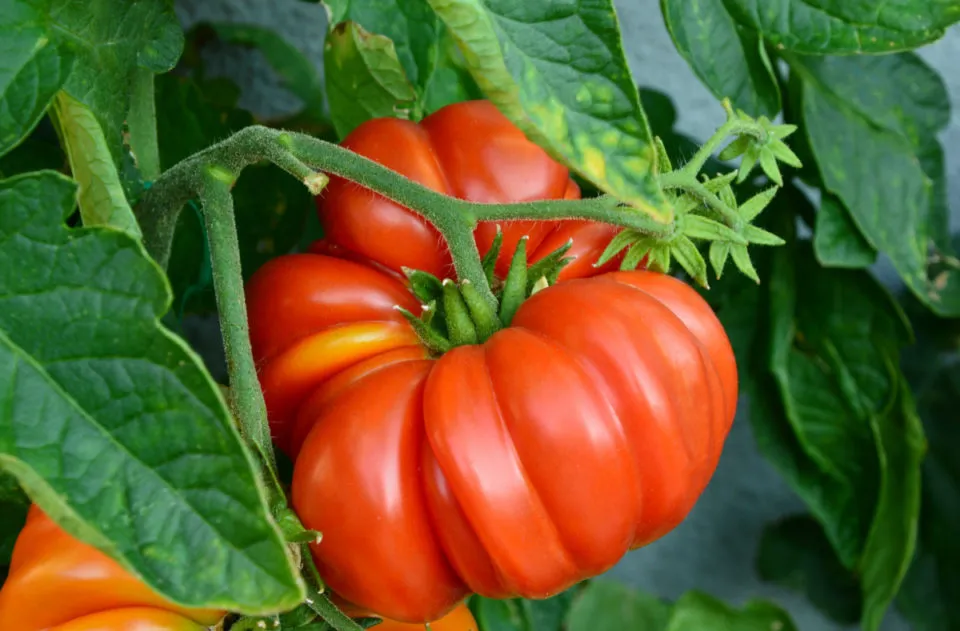Brandywine stands as one of the most beloved heirloom tomato varieties. It produces exceptionally large fruits revered for their sublime flavor.
Several sub-strains have emerged from the original Brandywine type, some boasting superior taste while others fall slightly short. However, all Brandywine varieties yield mighty, meaty fruits, often weighing over a pound. They assume a classic beefsteak silhouette and rank among gardeners’ favorites for their unrivaled rich, tomatoey flavor and hefty proportions.
When cared for properly, Brandywine plants grow vigorously and require substantial space. Trellising helps contain their sprawling vines. With the right conditions, gardeners will be rewarded handsomely with Brandywine’s legendary fruits all summer.
Key Brandywine Tomato Facts
- Origin: United States
- Type: Indeterminate
- Mature Height: 9+ feet
- Days to Harvest: 90-100 days from transplanting
Brandywine Origins & History
Brandywine’s exceptional traits have secured its place among the most prestigious heirlooms. Its fruits set the bar for depth of flavor and sheer size.
As with many heirloom tomato varieties, Brandywine’s precise origins and history are disputed and tricky to verify. However, this confusion is understandable since most home gardeners cultivate heirlooms rather than commercial farmers or seed companies.
The Amish community insists the original Brandywine type emerged from among them. Others posit a local farmer near Brandywine Creek – spanning southeastern Pennsylvania and northern Delaware areas – christened the variety after the creek in the early 20th century.
This region was settled by the Swedish and Dutch so that the name could derive from either group’s language. In Dutch, “brandewijn” translates to “distilled/burnt wine,” known as brandy in English. The Swedish term “brännvin” denotes a similar alcoholic drink, meaning “burnt wine.”
So, while the exact roots may remain shrouded in uncertainty, Brandywine’s legendary flavor is indisputable. Over a century since its inception, devoted gardeners still seek out its large, meaty fruits.
However, no definitive evidence confirms that the explanation is accurate.
We can verify the Brandywine tomato was listed in the prominent Burpee seed company’s catalog as early as 1882, where it went by the name ‘Turner’s Hybrid.’ Later, in 1886, they dubbed it simply Brandywine.
Muddying the waters further, there is no proof that those two Burpee varieties are identical to the Brandywine we know today – side-by-side comparison reveals some differences. The English also claim that this variety originally journeyed to America from their shores.
Around the same era, another major vegetable seed supplier for farmers, Johnson & Stokes (1881–1906), advertised a Brandywine tomato in the January 1889 edition of The Ohio Farmer magazine. So they, too, assert to be the first source.
Fast forward a hundred years, and the Brandywine heirloom entered the Seed Savers Exchange collection in 1982. According to accounts, Ohio gardener Ben Quisenberry acquired the seed from Dorris Sudduth Hill, who attested her family had preserved the strain for over 80 years straight.
This particular genetic line is identified as Brandywine Sudduth’s Strain. Today, gardeners rank it among the most popular heirloom varieties to cultivate.
Flavor Profile
This beloved tomato variety yields exceptionally large, meaty fruits bursting with an intense, rich flavor often humorously described as superbly tomatoey. Brandywine tomatoes are pleasantly juicy and mild-mannered, with a smooth, well-balanced sweetness rather than sharp acidity.
Many argue Brandywine achieves the ideal equilibrium of sweet and tart notes, resulting in a mellow, nuanced taste that shines when enjoyed fresh from the vine. Their rich, almost buttery texture also renders them perfect for savoring raw or incorporating into recipes requiring fresh tomatoes.
Some gardeners occasionally report certain Brandywine strains falling short on flavor intensity. For the best and most reliable results, selecting only the most reputable, sought-after varieties when procuring your seedlings is advisable.
Best Uses For Brandywine Tomatoes
Fresh from the vine is the ultimate way to enjoy these beauties, but Brandywine tomatoes shine across many cooked preparations. Their shelf life after picking is quite limited, so they should be used or preserved very soon after harvest. Slicing them fresh makes for sublime salad toppings or sandwich fillings. Chopped with garlic and a pinch of salt, they create possibly the ultimate bruschetta thanks to their stellar flavor.
Brandywine tomatoes also excel lightly cooked in a pan with garlic and basil as a quick pasta sauce. Scatter chopped chunks over pizza straight from the oven for glorious flavor enhancement. Soups and stews welcome their rich contribution as well. For bumper crops, turning them into a versatile tomato sauce, portioned and frozen for later use, allows you to make the most of their bounty.
Another preservation technique is oven-drying. Cut into chunks and slow-roast on very low heat for a couple of hours until shriveled yet still pliable. Cool completely, then pack it into sterilized jars, completely submerging it in olive oil. Refrigerated, these intensely flavored sun-dried tomato tidbits will keep for at least 3 months, ready to inject recipes with a burst of summer’s best.
What Are Brandywine Tomatoes Most Renowned For?
Brandywine tomatoes are most renowned for their coveted heirloom pedigree and excellent flavor. Enjoyed fresh from the vine, few tomato varieties can compete with Brandywine’s rich, nuanced sweetness.
In addition to their celebrated taste, Brandywines make a name for themselves with their impressively large fruits, sometimes topping 1.5 pounds apiece. Their vigorous vines can stretch over 10 feet tall, so just a few plants can yield bountiful harvests.
With meaty texture and thin skin that seldom cracks, Brandywine’s beefsteak-shaped beauties lend themselves exceptionally well to slicing sandwiches and burgers. Their mild acidity also renders them ideal for savoring raw with just a sprinkle of salt.
When it comes to flavor, versatility, and productivity, Brandywine has rightfully earned its stellar reputation among discerning heirloom enthusiasts. These tomatoes set the standard for texture and taste.
Where To Buy Brandywine Tomato Seeds?
Brandywine seeds are widely available from growers due to their popularity. The most commonly grown varieties include Brandywine Pink, Red, Yellow, Purple, Black, and Cherry. Some of the most popular seed suppliers online include:
How To Grow Brandywine Tomatoes?
Sow Brandywine tomato seeds indoors 6-8 weeks before your region’s last expected spring frost. Given proper conditions, the seeds should germinate within 7-14 days. The seedlings necessitate ample light and water; supplementing with grow lights often proves beneficial. Once the seedlings reach 3-4 inches tall with at least 3 sets of leaves, begin hardening them off to transplant outside.
Select a location receiving full sun, amending the soil thoroughly with compost and organic fertilizer. Avoid planting tomatoes where potatoes, peppers, eggplants, or tomatoes grew the previous year to sidestep diseases and pests often shared among nightshades.
Apply mulch to deter weeds and install cages or stakes to support the vines. Supply consistent water and an initial fertilizer higher in nitrogen to fuel vigorous growth. Upon flower formation, switch to one higher in phosphorus and potassium to nurture fruit production.
Pinch the seedlings’ tips once they hit 6–8 inches tall for bushier plants. Also, prune away lower growth up to 10 inches from the base to enhance air circulation, deterring common tomato afflictions.




